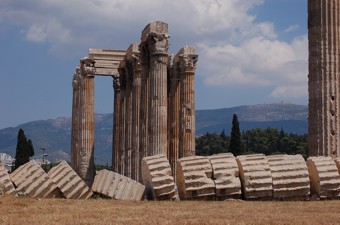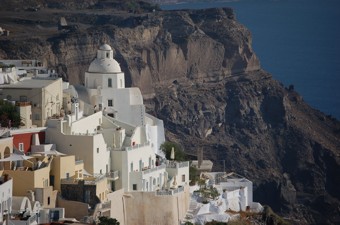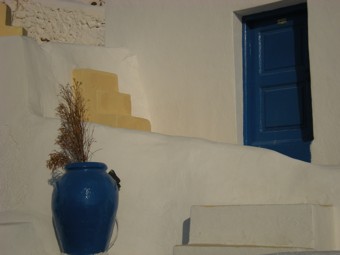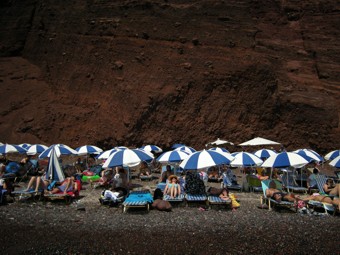Greece

General Info
Last visitedAugust 2008
FoodGreek salad consists of a piece of feta cheese, tomatoes, olives, red peppers, cuncumber and onion. Gyros can be compared with Doner kebab. They are prepared with kind of meat roasted on a vertical rotisserie. The most common fillings are tomato, onions, and tzatziki sauce. Fresh fish is usually barbecued and is quite expensive (30 - 50 EUR per kilo). Octopus is usually hangig outside the restaurant on a cord. It is prepared with vinegar and served as salad. Souvlaki is another common meat dish, pieces of meat on a spit. Moussaka is the Greek Lasagne prepared with potatoes and eggplant instead of pasta and tomato. Sometimes ago Greek people used to drink Ouzo a hard liquor made of anise and Retsina the Greek white wine having a resinous flavour. Nowadays it's fashion to drink Nescafé Frappe, served with ice. Its is stirred in an electric mixer and thus has a foam on top. Milk is optional.
TransportThe airport of Athens is quite away from the city. It is reachable by Metro which is operating from about 6am until midnight. There are also buses connecting the airport with Syntagma square operating 24 hours. The metro consists of about four lines and is the fastest means of transport in the city. Piraeus and the airport are part of the network. Tourists travelling by taxi take the risk to get overcharged. One of the most important means of transport is the ferry. Piraeus is the hub from where ferries depart to dozens of islands. Hovercraft vessels cost double the price of a classic ferry but are twice as fast. You can easily book via internet and pick up the tickets at the corresponding shipping company office. Public buses operate quite frequently between the beach resorts and main cities on the islands.
Don't... take a cab at Syntagma square in the middle of the night. We paied 17 EUR for the short trip between Syntagma and Omonia. More than 8 EUR should never be paied within the city at any night or day time.
Athens
Athens has apparently solved the traffic problem. Lots of streets converted to pedestrian areas. There's some parks and two major hills, Akropolis and Lykavittos. The most important sites can be visited in two days such as Akropolis, Temple of Zeus, Plaka and the Archaeological National Museum. Go to Plaka for dinner. Spend the evening hours on a table outside in one of the samll alleys between the Roman Agora, Aeropag and Akropolis, or have your meal on a rooftop restaurant, accompanied by a live band playing traditional Greek music. Don't expect the food to be of best quality, otherwise avoid Plaka.
Santorini
Santorini is a Cycladic island of volcanic origin. A couple of islands form a huge crater. Fira and Oia are two cities which are built on top of the crater demonstrating the best of Cycladic architecture. They are some of the most scenic places in the world. Oia is famous for its photogenic sunsets, its windmills and the church of blue coloured domes. Nevertheless it is recommended to stay in one of the hotels or pensions in Fira which is the capital, not as expensive as Oia and the hub of public transport. Fira has no beaches due to its location on top of the rock, but you can take the bus to go to one of the beaches. Don't miss Red Beach, it's a shingle beach in front of an enormeous red rock. The pebbles are of red and black colour.
Naxos
Naxos, another Cycladic island is a good supplement to Santorini. It is less touristy. Most of its beaches are of fine sand. They are spacious and not overly populated compared to the ones in Santorini. If you stay in Naxos Town what is recommended, don't miss to go for dinner in the small alleys of the old town. Hire a car for one day and explore the interior of the island, see the Kouros (figures of stone), ancient churches like Panagia Drossiani near Moni, have a swim in Mutsuna or Apollonas.
Paros
There are some nice beaches around Naoussa.

Temple of Olympian Zeus - Athens

Fira - Santorini

Cycladic still life - Santorini

Red beach - Santorini